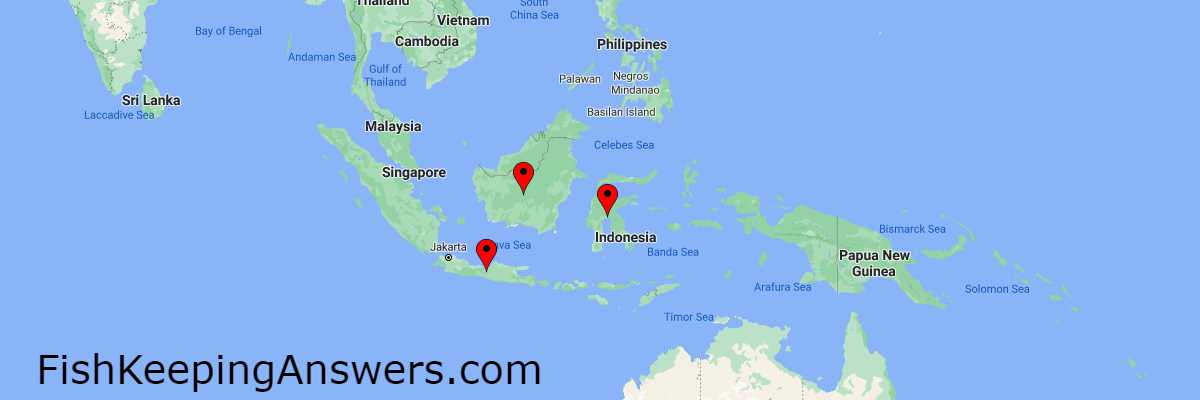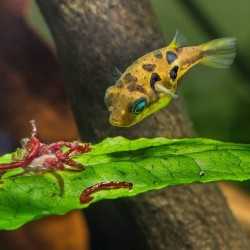Affiliate Disclaimer:
FishKeepingAnswers.com is reader-supported. When you buy through links on our site we may earn a commission.
The popularity of freshwater pufferfish has really grown over the last 10 years or so. From the tiny Dwarf Puffer to the mighty Mbu Puffer, there is a pufferfish to suit every tank and every budget. As more and more people get into keeping pufferfish, more people start looking at the slightly more challenging puffers. The Arrowhead Puffer is one that might fill the brief.
I have been keeping puffer fish for more than a decade at this point, and I would certainly say my Arrowhead Puffer is one of my favorite fish. They are not active fish, so don’t expect to be entertained by their swimming antics, but they are certainly a challenge!
Characteristics
| Common Name: | Arrowhead Puffer, Pignose Puffer |
| Scientific Name: | Tetraodon suvattii |
| Family: | Tetraodontidae |
| Origin: | Laos and Thailand |
| Tank Distribution: | Lower Regions |
| Adult Size: | 6″ (15cm) |
| Life Expectancy: | 10+ years |
| Care Level: | Difficult |
| Minimum Tank Size: | 20 US Gallons (75 Litres) |
| Breeding Method: | Egg layer |
| Temperature: | 72°F to 79°F (22°C – 26°C) |
| pH: | 6.5 – 7.5 |
| Hardness: | 5-12d°H |
Arrowhead Puffer Origins
The Arrowhead Puffer originates from the Mekong Basin in Thailand and also in Laos. This part of Southeast Asia is well known for its number of different pufferfish species.

Arrowhead Puffer Habitat
The Arrowhead Puffer naturally occurs in waterways that are rocky. It is often said the Arrowhead puffer tries to mimic rocks and small boulders whilst it is lying in wait for its prey. Roots and branches may also be present and there may be some vegetation.
What Size Aquarium For Arrowhead Puffer?
These puffers are not especially active. In fact, my Arrowhead puffer spends 95% of its time sitting buried in the sand. He only really moves when he is hungry and food enters the aquarium. As such, aquarium size is not that important.
My Arrowhead currently lives in a 20 gallon (75 litre) aquarium. If you have a larger aquarium available, by all means use it, but a 20 gallon aquarium is fine for an Arrowhead Puffer
How Should An Arrowhead Puffer Aquarium Be Set Up?
There is only one aspect of an Arrowhead Puffers aquarium setup that is crucial to get right, and that is the substrate.
Arrowhead Puffers want to hunker right down into the substrate to disappear. Arrowheads are hardcore ambush predators. They want to feel invisible until something tasty swims by, then they will strike.
Other than the substrate, the addition of a few smooth rocks and maybe some roots or driftwood will be appreciated. My Arrowhead Puffer has an open area in the middle with fairly large rocks around the edge.
I also have a couple of plants, but that’s more for my enjoyment than my puffers.
Filtration In An Arrowhead Puffer Aquarium
Unlike some other puffers, the Arrowheads don’t need huge amounts of flow. A regular canister filter will work just fine. I use a Fluval on my Arrowhead Puffers aquarium (like the ones I wrote about in this article on Fluval Filters).
The most important aspect of filtration in your puffer aquarium is the filter must be able to handle the highs and lows of puffer fish waste. Typically a puffer won’t eat for 4 or 5 days, then it will have a decent sized meal.
That decent-sized meal will lead to a decent-sized poop, which your filter will need to process quickly. Pufferfish like their water to be stable. Having an ammonia spike the day after feeding your puffer could prove fatal.
Arrowhead Puffer Behavior In The Aquarium
I can’t recommend enough that you keep your Arrowhead Puffer as a single fish in the aquarium. Arrowhead puffers are not sociable. They will eat anything that fits in their mouths and take a bite out of anything that won’t fit in their mouths.
If you want to try to keep multiple Arrowhead Puffers in a single aquarium, be certain to make sure it is large enough and there are LOTS of hiding places and line of sight blocks. Arrowhead Puffers do not play nicely, especially with members of their own species.
Other Members Of The Puffer Family
Pufferfish are extremely popular in the freshwater fishkeeping hobby at the moment. There are different-sized puffers to suit different-sized tanks and different experience levels. Pufferfish available range from the relatively cheap and easy to care for Pea Puffer (Pictured Photo Credit: Aquarium-Coop) which only reaches around 1.5 inches, to the giant Mbu Puffer which will reach 3ft or more and is only suitable for aquarists with extremely large aquariums, possibly needing 1000 or more gallons.

Below I have listed some of the most popular puffer species available in the hobby. One note of caution, common names for pufferfish vary by country, so always be sure to find the correct scientific name of the puffer you are purchasing before completing the sale.
- Pea or Dwarf Puffer (Carinotetraodon travancoricus)
- Fahaka Puffer (Tetraodon lineatus)
- Red-tailed Red Eye Puffer (Carinotetraodon irrubesco)
- Hairy Puffer (Tetraodon baileyi)
- Congo Puffer (Tetraodon miurus)
- Dwarf Malabar Puffer (Carinotetraodon imitator)
- Red Eye Puffer (Carinotetraodon lorteti)
- Amazon Puffer (Colomesus asellus)
- Humpback Puffer (Tetraodon palembangensis)
- Mbu Puffer (Tetraodon mbu)
What Do Arrowhead Puffers Eat?
Arrowhead Puffers are hardcore carnivores. They will not take to commercially available foods like pellets or sinking sticks. Instead, you need to feed your Arrowhead Puffer prawns, snails, small fish, and crustaceans.
The vast majority of Arrowhead Puffers available in the hobby are wild caught, so it can be a challenge transitioning them on to dead or frozen foods.
I had to spend a fair amount of time waving food on tongs in front of my Arrowhead before he would eat, but now he takes any meaty foods dropped into the tank.
Like many members of the puffer family, Arrowheads need to eat shelled foods like snails, clams, and crabs to keep their teeth in shape. Pufferfish have the issue that their teeth are continually growing. If they don’t wear them down by eating hard, shelled foods they become so long the puffer can no longer eat.
Breeding Arrowhead Puffers In Captivity
Arrowhead Puffers are one of the few puffers which have successfully been bred in captivity. Reports actually show that during spawning the Arrowheads become friendly and they are almost attentive to the needs of their mate.
Courtship may be very quick or spread out over several days. The Arrowheads will spend a lot of time laying next to one another, occasionally puffing up, showing their fins off and swimming in circles around each other. After a few days of ‘courting’ and keeping the chosen site clean of debris, the eggs will be laid and fertilized.
Once the eggs are laid, the male guards them day and night, fanning them to keep freshwater moving across the eggs. The eggs hatch in about 9 to 12 days. There is an excellent article on TFH Magazine website about spawning Arrowhead Puffers.
In Conclusion
I really enjoy keeping my Arrowhead Puffer and I would certainly recommend them to anyone who fancies a new challenge. They are not for the faint-hearted or for anyone who wants to watch their fish doing laps of the aquarium. If however, you are ready to take your fish keeping to the next level, maybe an Arrowhead Puffer is for you







